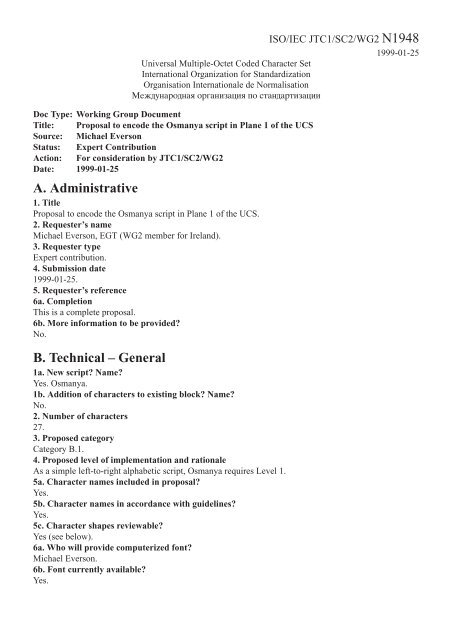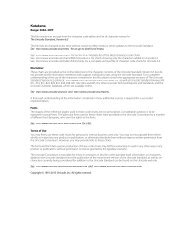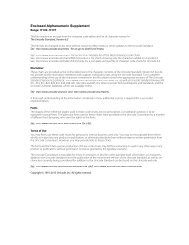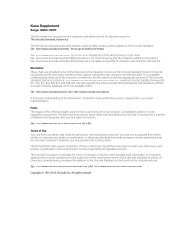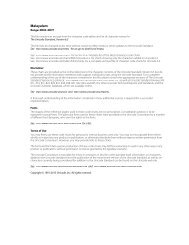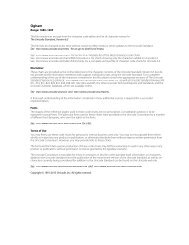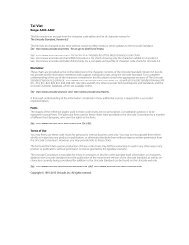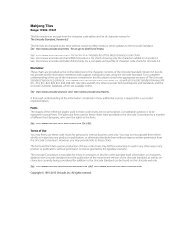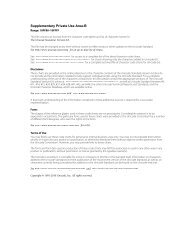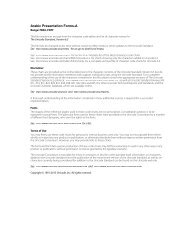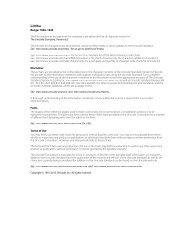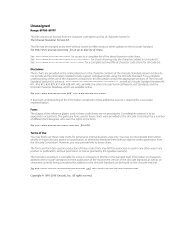n1948 osmanya - DKUUG standardizing
n1948 osmanya - DKUUG standardizing
n1948 osmanya - DKUUG standardizing
You also want an ePaper? Increase the reach of your titles
YUMPU automatically turns print PDFs into web optimized ePapers that Google loves.
ISO/IEC JTC1/SC2/WG2 N1948<br />
1999-01-25<br />
Universal Multiple-Octet Coded Character Set<br />
International Organization for Standardization<br />
Organisation Internationale de Normalisation<br />
Œåæäóíàðîäíàß îðãàíèçàöèß ïî ñòàíäàðòèçàöèè<br />
Doc Type: Working Group Document<br />
Title: Proposal to encode the Osmanya script in Plane 1 of the UCS<br />
Source: Michael Everson<br />
Status: Expert Contribution<br />
Action: For consideration by JTC1/SC2/WG2<br />
Date: 1999-01-25<br />
A. Administrative<br />
1. Title<br />
Proposal to encode the Osmanya script in Plane 1 of the UCS.<br />
2. Requester’s name<br />
Michael Everson, EGT (WG2 member for Ireland).<br />
3. Requester type<br />
Expert contribution.<br />
4. Submission date<br />
1999-01-25.<br />
5. Requester’s reference<br />
6a. Completion<br />
This is a complete proposal.<br />
6b. More information to be provided?<br />
No.<br />
B. Technical – General<br />
1a. New script? Name?<br />
Yes. Osmanya.<br />
1b. Addition of characters to existing block? Name?<br />
No.<br />
2. Number of characters<br />
27.<br />
3. Proposed category<br />
Category B.1.<br />
4. Proposed level of implementation and rationale<br />
As a simple left-to-right alphabetic script, Osmanya requires Level 1.<br />
5a. Character names included in proposal?<br />
Yes.<br />
5b. Character names in accordance with guidelines?<br />
Yes.<br />
5c. Character shapes reviewable?<br />
Yes (see below).<br />
6a. Who will provide computerized font?<br />
Michael Everson.<br />
6b. Font currently available?<br />
Yes.
6c. Font format?<br />
TrueType.<br />
7a. Are references (to other character sets, dictionaries, descriptive texts, etc.) provided?<br />
Yes. See the bibliography below.<br />
7b. Are published examples (such as samples from newspapers, magazines, or other sources) of use<br />
of proposed characters attached?<br />
Yes, see below.<br />
8. Does the proposal address other aspects of character data processing?<br />
Yes; see Unicode properties below.<br />
C. Technical – Justification<br />
1. Contact with the user community?<br />
No.<br />
2. Information on the user community?<br />
Probably only the scholarly and library communities, since the script was abandoned in 1973 in favour of<br />
Latin orthography for Somali.<br />
3a. The context of use for the proposed characters?<br />
Used to write Somali, especially from 1961–1973 (when Osmanya enjoyed official sanction); Osmanya<br />
was devised in 1920–22.<br />
3b. Reference<br />
See bibliography below.<br />
4a. Proposed characters in current use?<br />
Yes.<br />
4b. Where?<br />
By scholars and librarians; there could possibly still be some native use.<br />
5a. Characters should be encoded entirely in BMP?<br />
No.<br />
5b. Rationale<br />
Accordance with the Roadmap.<br />
6. Should characters be kept in a continuous range?<br />
Yes.<br />
7a. Can the characters be considered a presentation form of an existing character or character<br />
sequence?<br />
No.<br />
7b. Where?<br />
7c. Reference<br />
8a. Can any of the characters be considered to be similar (in appearance or function) to an existing<br />
character?<br />
No.<br />
8b. Where?<br />
8c. Reference<br />
9a. Combining characters or use of composite sequences included?<br />
No.<br />
9b. List of composite sequences and their corresponding glyph images provided?<br />
No.<br />
10. Characters with any special properties such as control function, etc. included?<br />
No.<br />
E. Proposal<br />
The Osmanya script, called in Somali far Soomaali ‘Somali writing’ or Ismanya, was devised in<br />
1920–1922 by Cismaan Yuusuf Keenadiid to represent the Somali language. It replaced an attempt by
Sheikh Uweys of the Confraternity Qadiriyyah (died 1909) to devise an Arabic-based orthography for<br />
Somali. It has in turn been replaced by the Latin orthography of Muuse Xaaji Ismaaciil Galaal (1914-<br />
1980). In 1961 both the Latin and Osmanya scripts were adopted for use in Somalia, but in 1969 there<br />
was a coup, with one of its stated aims the resolution of the debate over the country’s writing system.<br />
Latin orthography was adopted finally in 1973. Gregersen said in 1977 that some 20,000 or more people<br />
use Osmanya in private correspondance and in bookkeeping and that several books and a fortnightly<br />
journal Horseed (‘Vanguard’) was published, all “cyclostyped” which I take to be equivalent to<br />
“cyclostyled” and to mean ‘mimeographed’.<br />
Structure<br />
Osmanya is a simple alphabetic script, read from left to right in horizontal lines running from top to<br />
bottom. It has 22 consonants and five vowels. Long vowels are written with Arabic conventions: by the<br />
addition of ALEF to A; by the addition of WAW to U and O; by the addition of YEE to E and I. Long EE and<br />
OO can also be represented by doubling the signs.<br />
Ordering<br />
Alphabetical ordering follows the order of the Arabic alphabet, except that AIN (CAIN) and GHAIN (GAIN)<br />
appear to be reversed. This ordering, given in Diringer 1996, has been followed here. Diringer gives only<br />
the transliteration of the characters; in the names list below I have used the names of the Arabic letters of<br />
the alphabet, written in modern Latin Somali orthography. There may be errors in the spelling of the<br />
names.<br />
Issues<br />
Gregerson 1977 says the alphabet has 29 signs including 10 vowels, which doesn’t quite tally with the<br />
way I’d interpret the data. It would help if I could see Cerulli 1932 and Maino 1951, but all I have is<br />
Gregersen. Gregersen says that Cerulli describes long-vowel representation as represented here in this<br />
proposal (and which was also presented in Diringer 1947). He also says that Maino describes “special<br />
symbols, which were modifications of those used for the corresponding short vowels” as being used to<br />
represent long vowels. These sound to me like ligatures, but they are probably fixed ligature-letters like æ<br />
and œ, not contextual ligatures as in Arabic. The alphabets Gregersen gives are presented below in<br />
Annex A. He shows the following orders:<br />
Cerulli: € ‚ ƒ „ … † ‡ ˆ ‰ Š ‹ Œ Ž ‘ ’ “ ” • – — ˜ š<br />
? b t j x kh d r s sh dh g c f q k l m n w h y i u o a e<br />
Maino: ‚ ƒ „ … † ‡ ˆ ‰ Š ‹ Œ Ž ‘ ’ ” – — ˜ š • “ › € œ<br />
b t j x kh d r s sh dh g c f q k l m n h i u o a e y w o a e<br />
Where the two differ is that alef, waw and yee are considered long vowels, not consonants, and o and e<br />
have unique long forms as well. So it may be that there were two orthographies used. The sample given<br />
in Nakanishi shows its second-to-last character as what looks like an i-alef ligature. Gregersen says that<br />
Cismaan Yuusuf “himself denied ever using the system reported by Cerulli”.<br />
Code positions proposed in the table are based on my Roadmap to the BMP, version 3.0, 1999-01-23.<br />
Unicode Character Properties<br />
Spacing letters, category “Lo”, bidi category “L” (strong left to right)<br />
0001 2000 - 0001 201A<br />
Bibliography<br />
Cerulli, Enrico. 1932. “Tentativo indigeno di formare un alfabeta somalo”, in Oriente Maderno
12:212–13.<br />
Diringer, David. 1996 (1947). The alphabet: a key to the history of mankind.<br />
Munshiram Manoharlal. ISBN 81-215-0748-0<br />
Gaur, Albertine. 1992. A history of writing. London: British Library. ISBN 0-<br />
7123-0270-0<br />
Gregersen, Edgar A. 1977. Language in Africa: an introductory survey. New<br />
York: Gordon and Breach. ISBN 0-677-04380-5<br />
Maino, Mario. 1951. “L’alfabeta ‘Osmania’ in Somalia”, in Rassegna di<br />
Studi Etopici 10:108–21.<br />
Nakanishi, Akira. 1990. Writing systems of the world: alphabets, syllabaries,<br />
pictograms. Rutland, VT: Charles E. Tuttle. ISBN 0-8048-1654-9<br />
Annex A<br />
Sample from Nakanishi 1990.<br />
Transcription:<br />
†€ Šš•‡ ˜“ ‹— ‹—“‡ˆ†˜ ‚—‚•š ˜“ ‹— †š ˜<br />
dal dheyr low gu aa guwrsado shishaye low gu aa d e iio<br />
Sample from Gaur 1990.<br />
Transcription:<br />
Šš•‡ ˜“ ‹— ‹—“‡ˆ†“ ‚•<br />
dheyr low gu aa guwrsadw shay<br />
This text is suspect; it appears to be derived from the sample in<br />
Nakanishi 1990.<br />
To the right is shown Cerulli and Maino’s alphabets as given in<br />
Gregersen 1977.
Proposal for the Universal Character Set<br />
Michael Everson<br />
TABLE XXX - Row 20: OSMANYA<br />
200 201<br />
0<br />
1<br />
2<br />
3<br />
4<br />
5<br />
6<br />
7<br />
8<br />
9<br />
A<br />
B<br />
C<br />
€<br />
‘<br />
‚ ’<br />
ƒ “<br />
„ ”<br />
… •<br />
† –<br />
‡ —<br />
ˆ ˜<br />
‰ <br />
Š š<br />
‹ ›<br />
Œ œ<br />
G = 00<br />
P = 01<br />
D<br />
E<br />
Ž<br />
F<br />
5
Michael Everson<br />
Proposal for the Universal Character Set<br />
TABLE XXX - Row 20: OSMANYA<br />
dec<br />
hex<br />
Name<br />
dec hex Name<br />
00<br />
01<br />
02<br />
03<br />
04<br />
05<br />
06<br />
07<br />
08<br />
09<br />
0A<br />
0B<br />
0C<br />
0D<br />
0E<br />
0F<br />
10<br />
11<br />
12<br />
13<br />
14<br />
15<br />
16<br />
17<br />
18<br />
19<br />
1A<br />
1B<br />
1C<br />
1D<br />
1E<br />
1F<br />
OSMANYA LETTER ALEF<br />
OSMANYA LETTER BEE<br />
OSMANYA LETTER TEE<br />
OSMANYA LETTER JIIM<br />
OSMANYA LETTER XAA<br />
OSMANYA LETTER KHAA<br />
OSMANYA LETTER DAL<br />
OSMANYA LETTER REE<br />
OSMANYA LETTER SIIN<br />
OSMANYA LETTER SHIIN<br />
OSMANYA LETTER DHAD<br />
OSMANYA LETTER GAIN<br />
OSMANYA LETTER CAIN<br />
OSMANYA LETTER FEE<br />
OSMANYA LETTER QAF<br />
OSMANYA LETTER KAF<br />
OSMANYA LETTER LAM<br />
OSMANYA LETTER MIIM<br />
OSMANYA LETTER NUN<br />
OSMANYA LETTER WAW<br />
OSMANYA LETTER HEE<br />
OSMANYA LETTER YEE<br />
OSMANYA LETTER I<br />
OSMANYA LETTER U<br />
OSMANYA LETTER O<br />
OSMANYA LETTER A<br />
OSMANYA LETTER E<br />
OSMANYA LETTER OO ?????<br />
OSMANYA LETTER EE ?????<br />
(This position shall not be used)<br />
(This position shall not be used)<br />
(This position shall not be used)<br />
Group 00 Plane 01 Row 20<br />
6


